
Books for Native American History Month
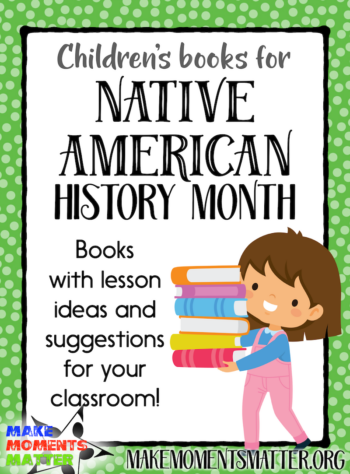
I absolutely love using books in my classroom because they open up so many possibilities. You can add a song, poem, or rhyme to make the book come to life and sing/speak it every few pages. You can teach a song that’s related to the content you read about in the book. The story you read can be the inspiration for a dance or composition. You can use the book to give historical facts and information. There are so many options!
Years ago when I was in college I took a World Religions class and my professor had us learn about the different religions by reading a textbook but also required us to read a series of novels. Each novel involved a character who was a part of the major religion that we were learning about in class. Through that class I learned that it’s one thing to read facts and details about each major religion but it’s a totally different thing to get involved and invested in a story from the perspective of an actual person who believes and lives that religion each and every day. I learned so much that semester and felt connected with the content and stories I learned about in a new and exciting way.
So, in my own classroom if I want to highlight a group of people, a time period, or a culture that my students aren’t a part of then I pull out my children’s books. This month is Native American History Month and I wanted to highlight a few of my favorite books to use in the classroom. Each of these books help to give my students a glimpse into another kid’s world and see through their story.
Below I’ll share a few of my favorite books and the ways that I integrate them into my elementary music classroom lessons. Yes, I usually add a poem, rhyme, game, or song to each story but sometimes I just read the book for the sake of reading the book. If you are inspired by any of the stories below drop a comment at the end of the post to share how YOU might use the book.
Jingle Dancer by Cynthia Leitich Smith
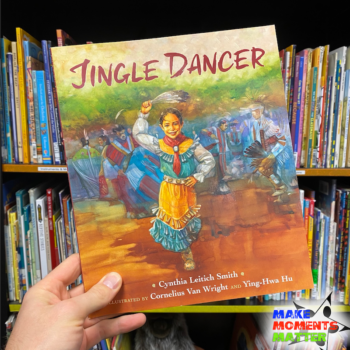
Jenna loves the tradition of jingle dancing that has been shared over generations in her family and intertribal community. She hopes to dance at the next powwow. But with the day quickly approaching, she has a problem—how will her dress sing if it has no jingles? The answer is easy, ask your community and family for help!
I love using “Jingle Dancer” to give kids a look into the preparation and traditions behind jingle dancing. They see how Jenna interacts with her friends and family and they learn why jingle dancing is so important to her. We learn about what jingle dancing means by learning the stories of different members of Jenna’s community.
After reading this book we talk about how Jenna uses the jingles and sews them onto her dress. Then we talk about other traditions where people wear instruments like bells on anklets, dancing with tambourines in hand, or even how musicians move while they play. Then we go to our nonpitched instrument cabinets and pull out a bunch of instruments. We turn this into a “how does it make sound” lesson as I ask kids “Could Jenna use this instrument as something to sew on her dress?” I’m basically asking “Does this particular instrument make sound by shaking/jingling?” We then go through and talk about the different types of nonpitched instrument: scrapers, shakers, metals, woods, and membranes.
Want a little more context? Use this video to show students what Jingle Dancers look like when they’re moving around with the beautiful jingles sewn into their dresses!
Let’s Hoop Dance by Violet Duncan

“Let’s Hoop Dance!” is a delightful father and son story about the gift of the Hoop Dance. This instant favorite offers a wonderful way to teach young readers about different Native American traditions and the significance of hoop dance. You can see father and son go through the steps of learning the dance, talk about the different shapes/patterns they can make with their hoops, and learn the significance of why they make each shape.
You can find the book at VioletDuncan.com but right now it says it’s out of stock. Keep checking back because I’m sure it’ll be available again soon. While you wait to get your own copy you can watch this video of the author reading the book herself. I also love to show this video of Tony Duncan (the father featured in the story) and his own hoop dancing:
In my classroom I don’t break out hula hoops to try and mimic the movements in the story because hoop dancing is not a part of my story and I am not a cultur bearer of that tribe or those traditions. When I read this book with kindergarten they are fascinated by the imagination of it all and how you can make connections between the shapes of the hoops and actual images. So, I hand out one mallet to each kid and we figure out what it could be if we used our imagination. The mallets quickly turn into corn on the cob, baseball bats, microphones, oar for paddling boats, and lots more. Then I ask the kids to work together and they come up with alien antennae, write out letters with their mallets, and create the handlebars of motorcycles. We aren’t trying to recreate the hoop dancing but use it as inspiration as we explore and create in our own space.
I Sang You Down From the Stars by Tasha Spillett-Sumner
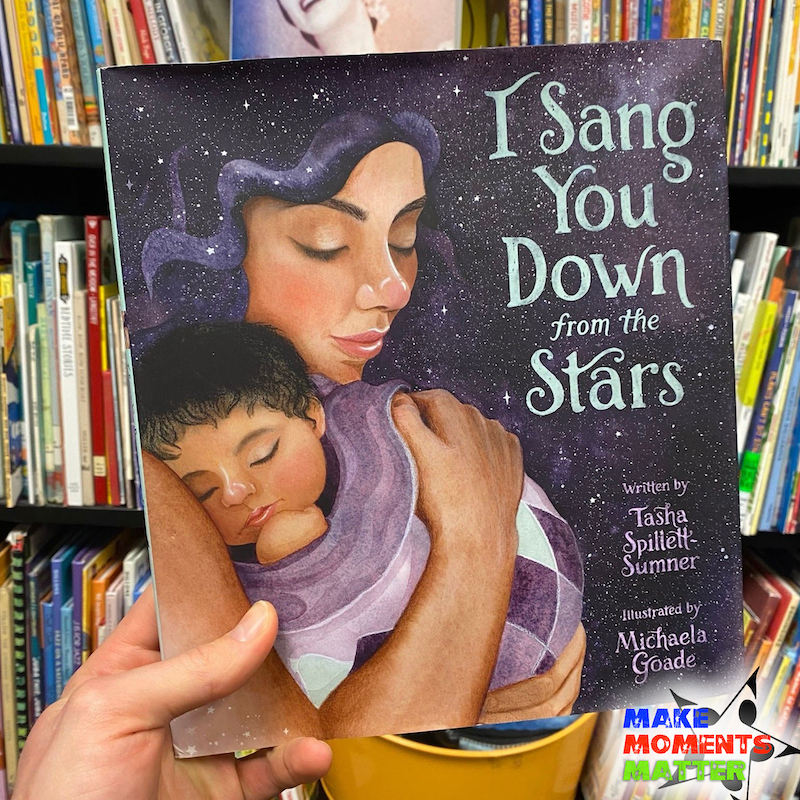
As she waits for the arrival of her new baby, a mother-to-be gathers gifts to create a sacred bundle. A white feather, cedar and sage, a stone from the river . . . Each addition to the bundle will offer the new baby strength and connection to tradition, family, and community. As they grow together, mother and baby will each have gifts to offer each other.
Elementary students are usually very familiar with pregnant women since they often see them in the community or even in our school – it feels like we have at least one “staff baby” every year 🙂 We read this book and then talk about how one might prepare for a baby: buying a crib, setting up a nursery, doing some research on what babies need, etc. Then we talk about what the mother in this story does to care for her baby and prepare. We also talk about the illustrations in the story and how they factor into the storytelling.
Then we talk about lullabies and their purpose in the life of a family. Sometimes babies need a calming and soothing song to help them go to sleep. Kids often tell stories about how their own parents sing to them at bedtime and what that’s like. We transition into learning a lullaby or two or maybe taking a song we already know and singing it as if it’s a lullaby.
Powwow Day by Traci Sorell

River wants so badly to dance at powwow day as she does every year. In this uplifting and contemporary picture book perfect for beginning readers, follow River’s journey from feeling isolated after an illness to learning the healing power of community. See the story through her eyes as she watches her friends and family dance and thinks about her place in the community and in the dance.
I love to use this book in music classroom to talk about different types of dance and the function of dance in different cultures! In elementary music we frequently teach about folk dance from around the world and how people used it for celebrations or rituals. When you use this book you can share about how Native American have integrated movement and dance into their traditions for centuries and why that’s important for them.
The book helps to explain the history and functions of powwows, which are commonplace across the United States and Canada and are open to both Native Americans and non-Native visitors. Author Traci Sorell is a member of the Cherokee Nation, and illustrator Madelyn Goodnight is a member of the Chickasaw Nation.
Maria Tallchief: The First Native American Ballerina by Baby Professor
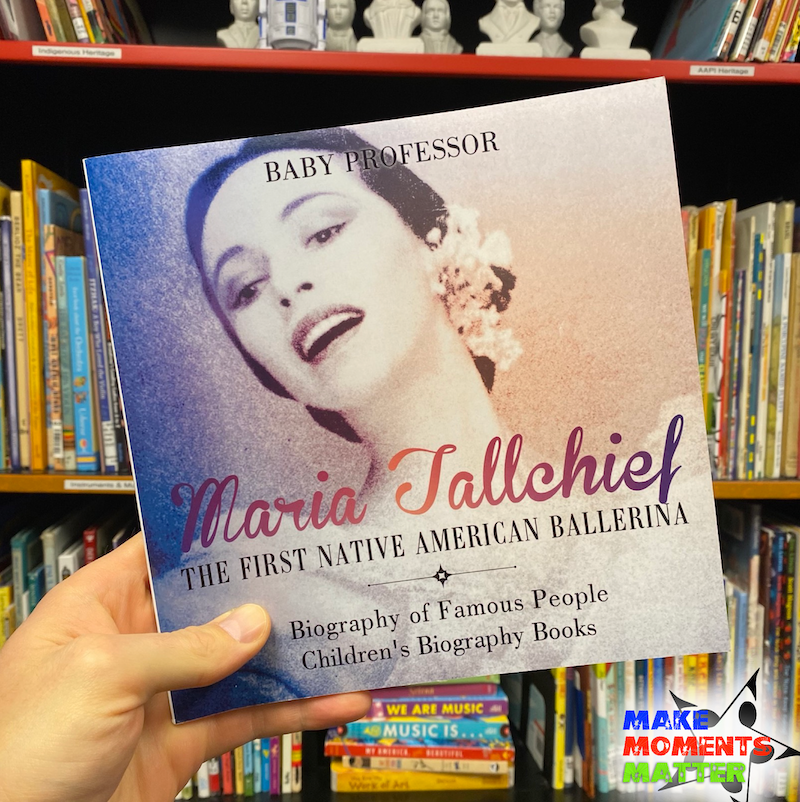
Elizabeth Marie Tallchief was America’s first major prima ballerina, was the first Native American to garner such acclaim as a ballerina, and is said to have revolutionized ballet. In this book, students learn both about Maria and about what it takes to be a ballerina. They learn about her early years, how she studied and progressed as a dancer, and her many accomplishments. This particular book is from a series called “Baby Professor” and is less of a narrative and more like a stylized textbook that gives facts and details.
I teach the Nutcracker EVERY year but it wasn’t until I read this book that I realized Tallchief married George Balanchine and danced the lead role in his production of the Nutcracker. I was so inspired that I went hunting for more information about Tallchief and her dancing. You can actually see Tallchief perform when you watch this video from the Kennedy Center in the 1960s.
The book gives a lot of great information and context for my students but I’ll often show this video to them as well to give them even more information. You could also show other videos of ballet or link this in with lessons about the Nutcracker. There are tons of options!
These are just a few of my favorite books and resources to use for Native American History Month. I’ve started making a list of my favorite books and have hosted that list here. If there are any books that you love to use that are not on that list, let me know and I’ll be happy to add them.
Want to learn how you can buy children’s books without breaking the bank? Check out this blog post about where and how I buy my children’s books.


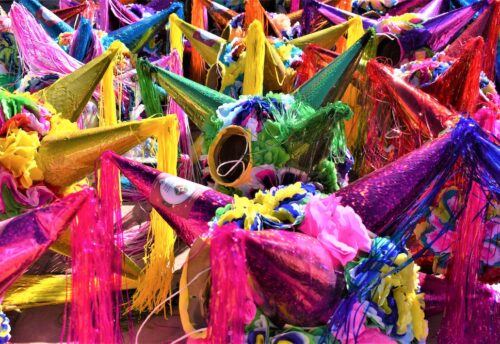
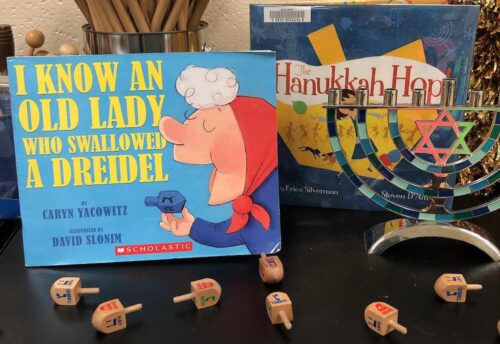
Leave a Reply